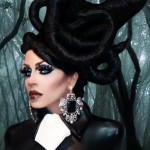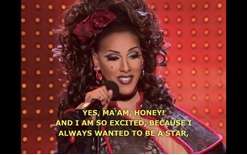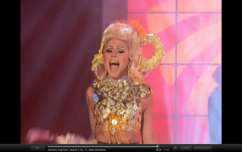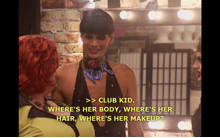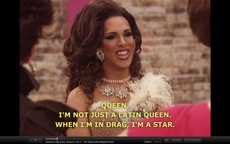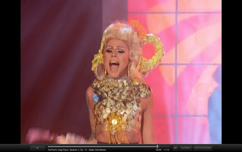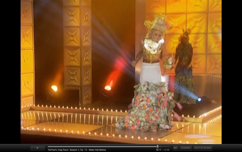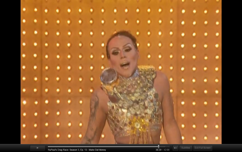| Lina M. Mendez is a junior in the Sociology Department at Princeton University. She is also pursuing certificates in African-American Studies and Gender and Sexuality Studies. She is from Miami, Florida. |
Embracing the Locura: Racialization, Reading, and Fierceness in RuPaul’s Drag Race
Introduction
The third season of RuPaul’s Drag Race, an American reality television program hosted by actor and drag queen RuPaul 1 2 3 featured two contestants from Puerto Rico: Yara Sofia and Alexis Mateo. Yara came to the United States to compete, but Alexis was already living in St. Petersburg, Florida when she auditioned. Both queens saw drag (see footnotes 2 & 3 above), and thus the performance of femininity and beauty, as a means to economic success and personal fulfillment. In their work ‘Past and Future Perfect? Beauty, Affect, and Hope’, Rebecca Coleman and Monica Moreno Figueroa build on interviews with Mexican and British teenage girls in order to conceptualize beauty as an aspiration, an inclination that is both ‘optimistic and cruel,’ in that its pursuit can be torturous, and its attainment is almost inherently impossible (Coleman & Moreno Figueroa, 2010: 357). I argue that the performance of beauty in drag enables Yara and Alexis to achieve happiness and satisfaction in a moment that is not transitory or elusive, but always destabilizing.
Drag, or the performance of gender, is a very fruitful yet largely untapped means through which one might explore the meanings and functions of body, beauty, and race. Reischer and Koo write, ‘beauty work’ has historically been the province of women, [and] examples of the body beautiful are drawn primarily from women’s ideal of beauty’ (Reischer & Koo, 2004: 298). When men or male bodies are included in scholarly or popular beauty discourses, it is almost always in a masculine context. What can we learn about the possibilities for beauty as empowerment by examining communities in which beauty is literally a way of life; when beauty maintenance and performances of femininity are explicit acts of resistance in a social system marked by sexism, homophobia, and transphobia? How does drag, and particularly its performance within poor minority communities, complicate debates that pit ‘beauty as oppression’ against ‘beauty as empowerment’?
Racialization in Drag
Yara and Alexis are identified as ‘The Latin Queens’ from the onset of the competition, and their characterization as such is maintained throughout the season, giving a prime example of a racialization process in operation. Sara Ahmed defines racialization as ‘a process of investing skin colour [and I argue, also bodies, dancing, and accents] with meaning’ (Ahmed, 2002: 46). She also insists that the project of deciphering racial bodies and the processes that produced them be contextualized with reference to European colonialism (Ahmed, 2002: 47). The white and North American gaze are two of many that ‘fix’ the bodies of Yara and Alexis (Ahmed, 2002: 56). It often seems like RuPaul cannot talk to Yara without referencing her nationality, with an underlying tone of exoticisation. 4
Yara Sofia and Alexis Mateo are constantly racialized throughout the contest. Each week, for example, the contestants are judged on their performance during the challenges and their ‘look’ by a panel. One week the contestants had to create a stand-up comedy routine in Episode 8: Ru Ha Ha. Both Alexis and Yara used their Puerto-Rican-ness as the butt of their jokes, which they were encouraged to do by the judges. 5 Alexis puts on darker foundation to make her skin darker to assume this role. 6 Yara dresses as a little person and attaches a large mole to her face and wears long, dark, curly hair and a flamenco dress. 7 Her accent is exaggerated, and the judges’ comment that they didn’t understand most of what she said: that she was too crazy. 8 Both queens wore similar dark, overdone makeup.
Another week the contestants made workout videos 9 Yara again emphasized her Latina-ness, and another contestant comments that her Puerto-Rican-ness is “too much”. 10 In the video and the judges’ critique, her body is identified as part of her Latin essence 11 Yara is the weathergirl in a faux morning news show for another week’s challenge. She is teased for not knowing where the states are on a map, and her broken English is both a point of amusement and of critique 12 In other episode, when the contestants have to dance, Yara and Alexis are both chosen to choreograph the routine. The other contestants comment on their particularly good dance skills, and Yara says it is because they are Puerto Rican. 13 Yara’s accent, in particular, as well as her high energy are constantly being critiqued in the show.
Reading
It is important to contextualize the ways the racialization of Yara and Alexis operates in a community that encourages ‘tough love’. As RuPaul says, ‘Reading is what? Fundamental!’ The term ‘reading’ here refers to a friendly but often cutthroat critique of other queens in the drag community. It is not vicious or meant to degrade; rather, it is a way of building a tough skin in a cruel world, and improving each other’s style and performance. In fact, the judges’ panel each week can be seen as an institutionalized form of it. The act of reading was featured in Jennie Livingston’s 1990 documentary film, ‘Paris is Burning’, which followed a community of drag queens in New York City in the late 1980’s 14 One featured queen identifies race as a fundamental aspect of reading (see quotation 3 in footnote 14 above). In the eighth episode of Drag Race’s third season, entitled Ru Ha Ha, the contestants must read each other for that week’s ‘mini challenge’. Each time Yara is ‘read,’ the ‘reader’ comments on her Latina-ness, and particularly her broken English. However, Manila Luzon and Shangela Laquifa Wadley (the only Asian American and African American contestants, respectively) are also ‘read’ for their race. 15
Reading provides an interesting counterpoint to what Mimi Nichter calls ‘fat talk’ in her study of white adolescent girls: ‘participation in ‘fat talk’’, she writes, ‘facilitates the creation and maintenance of social relationships: It provides a means for girls (and women) to signal their membership in a group and to demonstrate a socially appropriate degree of humility’ (Nichter, 2000: 55). In reading, a very different presentation is intended: while the purpose is also to build community and social ties, and the medium is conversational, the goal is not to demonstrate humility, but rather wit and a discerning sense of style. In reading, drag queens’ understanding of beauty resembles that which Nichter identified in her study of African American girls: ‘an egalitarian ethos is promoted, marked by mutual appreciation, cooperation, and approval of someone ‘who’s got it going on’’ (Nichter, 2000: 178). Reading is a performance, a demonstration of one’s drag experience and acquired wisdom: reading well demonstrates that she’s ‘got it going on’. Undoubtedly, there is a lot of underlying pain within reading, and this should be explored further. But it is different that an insult intended to hurt, because real reading occurs among people who experience similar oppression e.g. homophobia and transphobia: making fun of your sister is also making fun of yourself (see quotation 2 in footnote 14 above). Then again, the other contestants in RuPaul’s Drag Race are not Puerto Rican.
Embracing the ‘Locura’
Reading is central in Lawrence La Fountain-Stokes notion of the ‘transloca,’ a queer, diasporic Latin identity Yara in particular embodies 16 In explicating his reasoning behind the term, Lawrence describes it as ‘a name that friends call each one another as a sign of complicity and understanding; as a sign of being entendidos… not necessarily as a joke or hostile insult, although perhaps that too, if one is to do justice to cruelty as an art or strategy for survival; or simply as an acknowledgment of self-hatred’ (La Fountain-Stokes, 2008: 196). Here La Fountain-Stokes pinpoints the logic behind reading, and the processes through which it accomplishes community and empowerment. Yara is often called “too crazy” in the competition, and is told to tone it down (see footnote 8).
Like ‘bolero’, drag ‘is transformed into the motivation for a homosexual pilgrimage’ (La Fountain-Stokes, 2008: 191). In the thirteenth episode of Drag Race, the four remaining queens are asked why they deserve to be America’s Next Drag Superstar. Yara responds in a way that demonstrates how for her, drag is a way of life, as well as a means to life goals: I want to reach the American Dream, I want to make my own line of clothes. That is why I’m here, because I love drag, I love to make dresses. This is my life!’
The intensity of drag and of its meaning for these queens is embodied in Yara Sofia’s final moment on stage 17. She must lip-sync for her life. 18 against Alexis, but the prospect of leaving the competition is so overwhelming that she collapses on stage: ‘I’m crying because there is a lot of emotions. I’m so angry, and I’m so disappointed.’ She is disqualified, and Alexis remains in the competition as one of the final three contestants. Yara’s breakdown embodies a moment that La Fountain-Stokes locates in diasporic Puerto Rican drag and bolero—a highly emotional and destabilizing moment of performance (see quotation 2 of footnote 16 above). For Yara drag enables her to represent Puerto Rico with pride. Alexis Mateo, too, comments to Ru Paul that if she doesn’t win, Yara should, because a Puerto Rican should win the competition. 19 For both contestants prestige in the drag community is both the means to and an indicator of Puerto Rican national status.
Fierce: The Beauty of Drag
Historically, drag communities have functioned as safe havens for queer men, and in urban centers, particularly for minority races and ethnicities (Balzer, 2005: 111). In Ru Paul’s Drag Race, most contestants are not white, and the winners of the first three seasons were queens ‘of color’. Ru Paul comes from a tradition of predominantly African and Latin American queens in New York City—specifically Harlem—in the 1980’s (Balzer, 2005: 115): in the tradition of ‘Paris is Burning’. These queens identified drag as a way of life, and a means to comfort, fame, and happiness they dreamed of. Moreover, it empowers them; 20 21 22 it gives them a sense of belonging and importance in a world that treats queers and people of color like third-class citizens: ‘I like the competition. Makes me stronger. Makes me think more. It’s not just the winning; it’s the giving, too. Cause I feel I give a lot of enjoyment’ (Livingston, 1990).
Drag competitions are affective spaces where beauty, style, and overall fierceness (see footnote 3 above) are empowering experiences that are shared, and marginalized communities have a chance to take the stage and shine: ‘At a ball you have a chance to display your arrogance, your seductiveness, your beauty, your wit, your charm, your knowledge; you can become anything and do anything, right here right now, and won’t be questioned. I came, I saw, I conquered. That’s a ball’ (Livingston, 1990). Yara reiterates these emotions on Drag Race: ‘I’m doing my runway, and I feel like a queen, and it feels so great. I feel so powerful.’ For Yara, beauty, femininity, and the performance of both are tied to both her national identity and her pursuit of the American Dream. Beauty offers her a way to represent and feel proud in her home country, 23 and to achieve economic success in the United States (see footnote 19).
Drag puts forth a more flexible understanding of beauty—one that values attitude, performance, and wit. To be sure, every queen has her set of standards, and looks are often policed among performers: this is a fundamental aspect of reading. 24 (see also footnote 14) You critique each other to prove your expertise, to thicken your skin. But the fact that you can use your wit to heighten your fierceness demonstrates an inclusive take on beauty that emphasizes much more than what meets the eye (see footnote 2). Through reading, queens can claim their difference, their flaws, and say, ‘so what?’ And through this performance, communities are built across normative boundaries and social divisions.
Works Cited
Ahmed, Sara (2002) ‘Racialized Bodies’, in Mary Evans and Eliie Lee (eds) Real Bodies: A Sociological Introduction. Basingstoke: Palgrave.
Balzer, Carsten (2005) ‘The Great Drag Queen Hype: Thoughts on Cultural Globalization and Autochthony’, Paideuma, 51: 111-131.
Coleman, Rebecca and Figueroa, Monica Moreno (2010) ‘Past and Future Perfect? Beauty, Affect and Hope’, Journal of Cultural Research, 14:4, 357-373.
La Fountain-Stokes, Lawrence (2008) ‘Trans/Bolero/Drag/Migration: Music, Cultural Translation, and Diasporic Puerto Rican Theatricalities’, Women’s Studies Quarterly, 36, 3: 190-209.
Paris is Burning. (200) Documentary Film. Directed by Jennie Livingston.
Reischer, Erica and Koo, Kathryn S. (2004) ‘The Body Beautiful: Symbolism and Agency in the Social World’, Annual Review of Anthropology, 33: 297-317.
Nichter, Mimi (2000) Fat Talk: What Girls and Their Parents Say About Dieting. Cambridge: Harvard University Press.
RuPaul’s Drag Race (2011) Season 3, ‘LOGO’, April-May 2012, http://movies.netflix.com/WiMovie/RuPaul_s_Drag_Race/70187741?trkid=8133737.
Footnotes
-
Program Overview
RuPaul’s Drag Race is an American reality television program produced by World of Wonder for LOGO, a digital cable channel owned by Viacom Media Networks that creates shows related to Lesbian, Gay, Bisexual, Transgender, and Queer life:
“At the end of the day all our programming is about being your fierce, unconventional self… We chose the name “Logo” because a logo is an identity and nothing’s more important than having your own, unique identity, and making it work for you. Your logo is your symbol, it’s what you put forward with pride, it’s who you are, and it’s what we are.”
The series premiered on February 2, 2009 in the United States, and it just completed its fourth season, the final episode of which aired on April 30, 2012. It is a competition series to find “America’s Next Drag Superstar”, and contestants are chosen from a large pool of applicants who send in audition tapes to the show’s producers and creator, RuPaul Charles, a renowned drag performer. While anyone can audition to be on the show, as long as they are over 21 years old and biological males, all contestants from the first four seasons were from North or South America, or from the Caribbean.
Contestants are “drag queens”: male-bodied persons who assume mental and physical feminine alter egos. Each episode consists of two challenges (“mini” and “main”) related to drag queen identity, transformation skills, fashion, and/or performance, and a runway walk. A panel of judges, including RuPaul and other celebrity personalities, determines which contestant will be sent home each week. The two weakest performers are identified, and they must “lip-synch for their lives,” a final challenge that determines whom among them will be sent home.
The last episode focuses on the final three contestants after weeks of elimination. The winner of the competition wins the title, America’s Next Drag Superstar, a lifetime supply of a particular line of cosmetics, a headlining spot on the show’s post-season performance tour sponsored by Absolut, a lump sum of money, and other prizes provided by sponsoring organizations.
http://www.logotv.com/shows/rupauls_drag_race/season_4/series.jhtml
http://www.logotv.com/about/faq.jhtml ↩
-
Drag Queen
Definition
i) A drag queen is a man who dresses, and usually acts, like a caricature woman often for the purpose of entertaining. There are many kinds of drag artists and they vary greatly, from professionals who have starred in films to people who just try it once. Drag queens also vary by class and culture and can vary even within the same city. Although many drag queens are gay men, there are drag artists of all genders and sexualities who do drag for various reasons or purposes. Women who dress like men for the same purpose are known as drag kings.
Generally, however drag queens are males who dress in a female gender role, often exaggerating certain characteristics (such as make-up and eyelashes) for comic, dramatic or satirical effect. Other drag performers include drag kings, who are women who perform in male roles, faux queens, who are women who dress in an exaggerated style to emulate drag queens and faux kings, who are men who dress to impersonate drag kings.
The term drag queen usually refers to people who dress in drag for the purpose of performing, whether singing or lip-synching, dancing, participating in events such as gay pride parades, drag pageants, or at venues such as cabarets and discotheques. In the United Kingdom, alongside traditional drag work such as shows and performances, many drag queens engage in ‘mix-and-mingle’ or hosting work at night clubs or at private parties/events. Drag is a part of Western gay culture.
http://en.wikipedia.org/wiki/Drag_queen
ii) The word “drag” comes from William Shakespeare at the time when women were not allowed to be actresses in theater. It means “Dressed As Girl” to design a male actor playing the part of a female.
-
Fierce
Definition
i. Being bold, displaying chutzpah, especially relating to fashion, clothes, hair or makeup.
ii. A term mostly used by gay men to describe something good (example 1) or the way someone is dressed (example 2).
iii. The act of being bold, daring, and/or (highly) creative.
iv. Extremely FABULOUS! high fashion, very couture, VERY posh! EVERYTHING done with extreme CONFIDENCE!! http://www.urbandictionary.com/define.php?term=fierce
- Reunion Episode.
i) Context. Fans voted and Yara is the winner of Ms Congeniality, and award for the most loved contestant. She gets a free trip to the Bahamas.
ii) Dialogue
RuPaul: “Thousands of fans voted, and we have a winner. The one queen America loves to like is, Yara Sofia! Lucky for you, only one island over from where you live! You can swim there! ↩
- Scene 3
i) Context
All of the contestants get ten minutes to practice their routines with Rita Rudner, a white North American actress. She gives Alexis suggestions for what she should talk about.
ii) Dialogue
Alexis: “(I’m) going to talk about my “Coming to America” experience. It was a big change. It was the problem with the language. I love laughing at myself.”
Rita: “Maybe, let’s make a joke about that. You say (puts on accent), “I came to Miami. I was in first class. I was in the front of the raft.”
Alexis: “I was in the – in the what?”
Rita: “In the front of the raft.”
Alexis: “In the raft?”
Rita: “Yes, that’s a raft”
Alexis: “Girl, I don’t know if I can pronounce that”. ↩
- Scene 4
i) Context. Alexis’s stand-up routine.
ii) Dialogue. “It’s not Angelina Jolie, it’s not Beyonce; It’s your girl Alexis Mateo, all the way from Puerto Rico! Yes, ma’am, honey! And I am so excited, because I always wanted to be a star. Honey so I left Puerto Rico behind, and I moved to United States, all the way to Florida. I did travel in first class, right in front of that boat, baby. Honey I’m a Latina girl, and I only have two options in this country-being a housekeeper or being a stripper bitches. And you all know I didn’t came here to clean toilets, baby, so I became a stripper, baby! Yes, ma’am. I am here, and I’m queer baby!”
iii) Screenshot of Stand-up
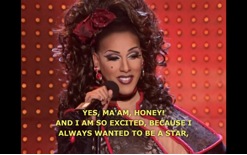 iv) Screenshots of Alexis when she isn’t portraying a “Latin Queen”
iv) Screenshots of Alexis when she isn’t portraying a “Latin Queen” - Scene 2
i. Context. The contestants have to come up with their own stand-up comedy routine. Yara assumes the character of a little person named Blara with exaggerated features and a flamenco dress. Her jokes are based on a date with a man with a very large penis; they go back to his apartment, have sex, and Yara has diarrhea.
ii. Dialogue.
Yara: I met a guy in a club, and he took me to wonder restaurant. He call McDonald’s. You want chicken sandwich? I go, “What the hell is chicken?” Pollo!
iii. Screenshot.
- Scene 5
i. Context. The judges critique Yara’s stand-up.
ii. Dialogue.
Yara: “This is the standars comendy that comedians do in Puerto Rico”.
Judge 1: “I don’t know what you talked about, except chicken and some shit!”
Judge 2: “That bitch was crazy!” ↩
- Episode 4: Totally Leotarded. Scene 1
i) Context. The contestants have to make a workout video. They are split into teams. Each contestant has to come up with her own routine, and make it funny. Yara comes up with a workout pose that is exaggeratedly swishing your hips from side to side, and saying “echa pa’lante”. In the following scene, Yara is explaining what this means to RuPaul.
ii) Dialogue
Yara: “It’s called echa pa’lante”.
Ru Paul: “Oh, help me with that”.
Yara: “It means move forward. You want to look like this, you have to work it out, darling. So, echa pa’lante (snaps fingers). If you don’t understand me, don’t worry: I will include a translation at the end of the video” (RuPaul laughs loudly) ↩
- Episode 4: Totally Leotarded. Scene 2.
i. Context. Yara’s does her routine, and Delta comments on it in the confessional.
iii. Dialogue.
Delta Work: “I feel like I am making a video with Uber-Charro.” ↩
- Episode 4. Totally Loetarded. Scene 3
i. Context. The judges comment on Yara’s workout routine after she walks the runway at the end of the show. Capitals signify emphasis made by judges.
ii. Dialogue
Judge 1: “You took a potential liability, which is your accent, and you made it work for you.”
Judge 2: “That whole Latin thing, and that sexy swish, you had everyone roaring.”
Judge 3: “She’s VERY sexy.” ↩
- Episode 5. QNN News
i. Context. The contestants have to make a mock morning television program. Yara is the weather girl. Earlier in the episode, RuPaul and the other contestants laughed at Yara when she tried to point out states on an imaginary map. The judges critique her performance after she walks the runway.
ii. Dialogue.
“Girl, you forced me to believe everything you said, even though I didn’t understand anything you said. Slow down, OR, don’t even speak a word of English”. ↩
- Episode 13. Make Dat Money. Scene 2.
i. Context. The contestants have to come up with a dance routine for the runway show. Yara and Alexis choreograph.
ii. Dialogue.
Manila: “How do you do that?”
Yara: “Eh, we are Puerto Rican darling, we have the move inside!” ↩
- Paris is Burning
i. Director Jennie Livingston
ii. Quotation 1: “Shade comes from reading. Reading came first. Reading is the real art of insult.”
iii. Quotation 2: “If it’s happening between the gay world and the straight world, it’s not a real read. It’s more of an insult. But it’s how they develop a sense of how to read.”
iv. Quotation 3: “But then, when you are all of the same thing, you have to go to a fine point. In other words, if I’m a black queen, you’re a black queen, we can’t call each other black queens, cause that’s not a read, that’s just a fact. So then we talk about, your ridiculous shape, your saggy face, your tacky clothes.” http://movies.netflix.com/WiMovie/Paris_Is_Burning/60036691?trkid=2361637 ↩
- Scene 1.
i. Context. The mini challenge of this episode is “reading”. The girls take turns reading each other and RuPaul picks the winner.
ii. Dialogue.
RuPaul: “In the great tradition of Paris is Burning, break out your library cards! Because reading is, what? Fundamental!”
Yara: “Manila Luzon, it’s not because you’re Asian; I need some patience to deal with you.”
Alexis: “Shangela girl, can we have some water? Her hair is thirsty, baby.”
Delta Work: “Yara, isn’t it interesting that when your flight came into town, sightings of Chupacabra increased?” ↩
- Trans/Bolero/Drag/Migration: Music, Cultural Translation, and Diasporic Puerto Rican Theatricalities
i. Author. Lawrence La Fountain-Stokes
ii. Quotation 1. “I wish to offer an enabling vernacular critical term that accounts for the intersection of space (geography) and sexuality in the work and lived experience of queer diasporic artists who engage in male-to-female drag… Translocas” are many things, contradictory ones, to be sure: performers, queers, innovators, marginals, exiles, eccentrics, beauties, troublemakers, lovers, loners, and friends. To be a transloca is to disidentify with dominant social mores… to tread dangerous ground, make and break allegiances, and redefine meanings and sensibilities” (La Fountain-Stokes, 2008: 194-195).
iii. Quotation 2. “(Pure) emotion, by which I mean the distilled or condensed intensity of affect that breaks forth, free of social convention, and speaks its truth, as cruel hyperbole and that sees the world as a stage for the taking and the subject as a star” (La Fountain-Stokes, 2008: 192). http://www.jstor.org/stable/27649795?seq=7&Search=yes&searchText=locura&list=hide&searchUri=%2Faction%2FdoBasicSearch%3FQuery%3Dlocura%2Bbolero%26acc%3Don%26wc%3Don&prevSearch=&resultsServiceName=null ↩
- Episode: Make Dat Money. Scene 3
i. Context. Yara and Alexis are both in the bottom two and have to lip-sync for their lives. Yara breaks down in the middle of the routine: she falls to the floor, crying and covering her face. Both contestants’ confessionals are voiceovers during the performance.
ii. Dialogue.
Alexis: “Yara is my sister, and I know what this competition means to Yara; she wants this so bad.”
Yara: “I’m crying because there is a lot of emotions. I’m so angry, and I’m so disappointed. This is for Puerto Rico, so I’m gonna echar pa’lante, darling. I did my best, and this is me. I don’t know. I have too much to offer.”
iii. Screenshots of Yara
- Lip-Sync For Your Life.
Definition
Lip-syncing for your life is the final elimination challenge the contestants of RuPaul’s Drag Race compete in each episode. The bottom two, or the weakest performers/queens that week (selected by the judges) have to lip-sync to a song of RuPaul’s choosing. At the beginning of each challenge the queens are told which song the bottom two will have to lip-sync that week, and each contestant prepares their performance in case they are in the bottom two. Lip-syncing is a form of performance art in which the performer mouths along to the words of a song for entertainment purposes. The performer feigns actual singing, dances, and generally shows off her fierceness. It is a common form of entertainment in the drag community. ↩
- Scene 1.
i. Context. The final four contestants remain. RuPaul walks around the workroom where the queens make their outfits. Alexis and Yara talk to her about their thoughts on winning.
ii. Dialogue.
Alexis: “If I don’t win this competition, another Puerto Rican should be crowned.”
Yara: “I’m broke! But I’m still fabulous! (If I win) I’m going to move probably to the states. Puerto Rico, it’s hard to find a job. I want to reach the American Dream; I want to make my own line of clothes. That is why I’m here, because I love drag, I love to make dresses. This is my life! I deserve it; I want Alexis in the top three!” ↩
- Episode 1. Audition Tapes.
i. Context. This is an excerpt from Yara Sofia’s audition tape. Alexis Mateo’s audition tape did not air. Capitals signify emphasis Yara made. RuPaul comments on the audition tape in a television studio.
ii. Dialogue.
Yara Sofia: “I’m Gabby, a.k.a. Yara Sofia, I’m from Puerto Rico, I was born and raised here, in this beautiful Island. My character’s name come form a girl from high school, she have beautiful legs, so everybody told me I have beautiful legs, that’s why I’m Yara Sofia. When I looked in the mirror, I wasn’t a boy, I was a girl, cause I LOVE being a girl. NOW we gonna talk FASHION. I’m a FIERCE bitch. I want to compete in this fabulous race, Ru Paul drag race, so here I am, this is the time, so be prepared, watch me!”
Ru Paul: “Escandalo!” ↩
- Episode 7. Face, Face, Face Off
i. Context. The queens have to make outfits that embody a particular type of cake. Yara is assigned Strawberry Shortcake. She comments on her skills in the confessional.
ii. I love to sew! I’m a strong, wicked bitch! I’m bringing a Puerto Rican strawberry shortcake. ↩
- Episode 9. Life, Liberty, and the Pursuit of Style. Scene 2.
i. Context
Yara’s father is in the military and currently serving abroad. As she puts on her makeup for the runway, she describes what she would like to say to him to the other contestants.
ii. My darling be proud: you don’t have a son, but you have a drag queen! ↩
- Episode 9. Life, Liberty, and the Pursuit of Style. Scene 1
i. Context. The contestants have to make a patriotic video to send to the troops in Iraq. They write their script, direct, and make their outfit.
ii. Dialogue
“I’m Yara Sofia, I’m Puerto Riquena, I’m American Girl! I’m Yara Sofia and I love America, because America let me be the LATINA!” ↩
- Episode 3. Queens in Space. Scene 3
i. Context. Alexis comments on another contestant, Raja, when she enters the room to meet the other queens.
ii. Dialogue
Alexis: “Club kid Where’s her body? Where’s her hair? Where’s her makeup? I don’t see her on the same level as the rest of us.”
iii. Screenshots

